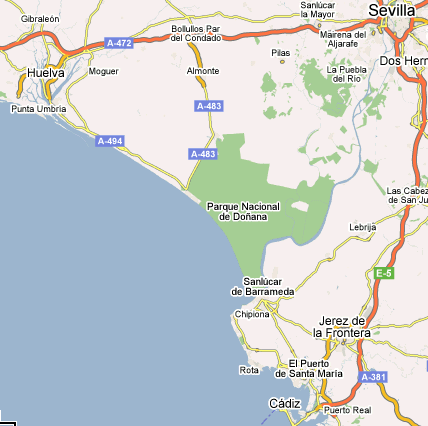José Pellicer
Doñana Marshes *
 The Doñana Marshes, a National Park in the valley of the Andalusian Guadalquivir River was linked with Atlantis over 400 years ago by José Pellicer. During the 1920’s George Bonsor and Adolph Schulten searched the area for evidence of Tartessos. After that interest in the marshes waned until a few years ago when Werner Wickboldt identified circular and rectangular features in the Park from satellite images, which he claimed a possibly Atlantean.
The Doñana Marshes, a National Park in the valley of the Andalusian Guadalquivir River was linked with Atlantis over 400 years ago by José Pellicer. During the 1920’s George Bonsor and Adolph Schulten searched the area for evidence of Tartessos. After that interest in the marshes waned until a few years ago when Werner Wickboldt identified circular and rectangular features in the Park from satellite images, which he claimed a possibly Atlantean.
Richard Freund, a professor from the University of Hartford, claims to have led a team to study the area and has had work included in a March 2011 National Geographic documentary, Finding Atlantis. However, Spanish anthropologist Juan Villarias-Robles who has worked on the site for some years has declared(a) that Freund did not lead the investigations on the site and in fact spent less than a week there. Wickboldt’s images turned out to be either smaller than expected or were from the Muslim period. Evidence for Tartessos or Atlantis has not been found.
(a) Muddying up Atlantis – Roger Catlin | TV Eye (archive.org) or see Archive 2122*
Pellicer de Ossau Salas y Tovar, José
José Pellicer de Ossau Salas y Tovar (1602-1679), a Spanish writer, was probably the  first in 1673[1315] to identify an Andalusian location for Atlantis, proposing that Tartessos was identical with Atlantis and that it was located on the Guadalquivir River in southern Spain near Seville. He specified the Doñana Marshes, where, coincidentally, Kühne and Wickboldt had identified ground features using satellite images, which they claimed corresponded with Plato’s description of Atlantis.
first in 1673[1315] to identify an Andalusian location for Atlantis, proposing that Tartessos was identical with Atlantis and that it was located on the Guadalquivir River in southern Spain near Seville. He specified the Doñana Marshes, where, coincidentally, Kühne and Wickboldt had identified ground features using satellite images, which they claimed corresponded with Plato’s description of Atlantis.
However, subsequent excavation there showed Wickboldt’s images to be smaller than expected or were from the Muslim period. Evidence for Tartessos or Atlantis has not been found.
